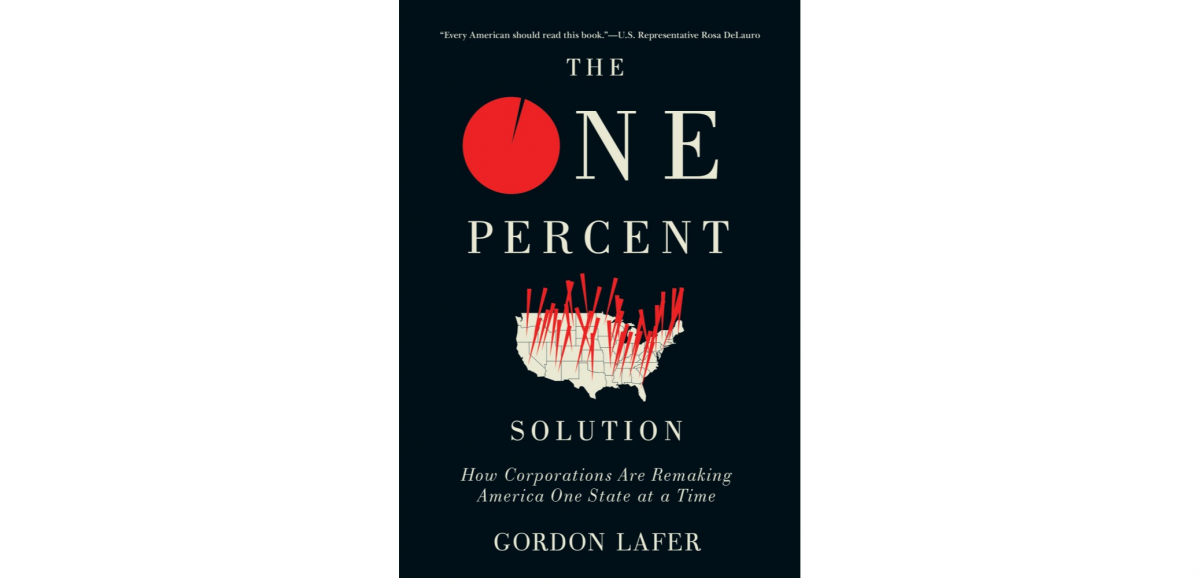Public Sector Right to Work: Gateway to Combating All Unions

The One Percent Solution: How Corporations Are Remaking America One State at a Time, by Gordon Lafer. Cornell University Press, 272 pp.
Corporations are making the most headway on their anti-worker agenda by buying state legislatures, argues Gordon Lafer in his new book, The One Percent Solution: How Corporations Are Remaking America One State at a Time.
An excerpt from Chapter Two of the book, “Deunionizing the Private Sector,” is provided below. For more, see the full interview with Lafer on the Labor Notes website.
In 2006, Indiana governor Mitch Daniels was the guest of honor at a dinner hosted by the Teamsters union. The year before, on his first day in office, Daniels had issued an executive order abolishing collective bargaining for state employees. Now he had come to reassure the Teamsters that nothing similar was coming their way. “I’m a supporter of the labor laws we have in the state of Indiana,” the governor promised. “I’m not interested in changing any of it. Not the prevailing wage laws, and certainly not the right to work law.” Just one year after the Citizens United decision, however, Daniels reversed course and signed right to work into law. And in 2015, Indiana repealed its prevailing wage law.
Daniels’s comments singled out the two types of laws most feared by private-sector unions: so-called right-to-work laws (RTW) designed to undermine private sector unions, and prevailing wage laws, specifically targeting unions in the construction industry. RTW does not, as the uninitiated might suppose, entail any guarantee of employment for those ready and willing to work. Rather it makes it illegal to negotiate a union contract that requires all employees who benefit from the terms of the agreement to pay their fair share of the costs of negotiating and administering it. RTW laws thus put unions in the unique position of being required by federal law to provide all their benefits and services for free, without being able to charge for those services. Their most direct impact is to erode unions’ budgets and, ultimately, to make them financial unviable. Thus private sector unions regard RTW as an existential threat akin to that posed by the restriction of bargaining in the public sector.

SUPPORT LABOR NOTES
BECOME A MONTHLY DONOR
Give $10 a month or more and get our "Fight the Boss, Build the Union" T-shirt.
While RTW laws affect all private sector unions, their impact is lessened in the construction industry. Because construction unions provide highly specialized training for their members, skilled tradespeople generally remain dues-paying members even under RTW laws. Instead, what strikes at the viability of building trades unions is the abolition of prevailing wage—a New Deal-era principle that publicly funded construction should not undercut the going wage in a local area. Undoing such laws allows low-wage contractors to flood into an area, underbid better-paying union contractors, and slowly drive them out of this critical part of the industry.
When the national legislative offensive against public sector unionism got under way in 2011, its champions insisted—like Daniels—that their concern was strictly limited to government employees. Elected officials went out of their way to distinguish the dismantling of public sector bargaining from their support for private sector unions. In Wisconsin, for instance, Governor Walker proclaimed private sector unions “my partner in economic development” and pledged that he would do “everything in my power” to guarantee that RTW legislation “is not going to get to my desk.” Similarly, when Rick Snyder campaigned for office of governor of Michigan in 2010, he insisted that RTW would “create a divisive atmosphere that would prevent too many good things from happening.” In 2011, Snyder supported legislation curtailing collective bargaining rights for public employees but repeatedly stressed that he had no interest in RTW.
However, after successfully passing laws to weaken public sector unions, Indiana, Michigan, and Wisconsin all did exactly what their governors had forsworn. Indiana was the first to abolish public sector union rights, and it became the first to adopt RTW, with Governor Daniels signing the law in early 2012. Elsewhere, the strategy was first to cripple public employee unions and only afterward to focus on the private sector. Shortly after being sworn into office, Wisconsin governor Walker was approached by an important donor who asked if there was “any chance we’ll ever get to be … right to work?” “Well,” Walker answered, “the first step is we’re going to deal with collective bargaining for all public employee unions, because you use divide and conquer…. That opens the door once we do that.” That, indeed, appears to be the strategy that Walker and others followed. At the end of 2012, Michigan governor Snyder reversed his earlier position and signed a RTW law that was sprung on the public in a lame-duck session and rushed from introduction to signing—with no committee hearings or public comment—in less than a week. In Wisconsin, Walker continued to pronounce RTW a “distraction” through the end of 2014 but apparently decided the timing was right shortly thereafter, and in February 2015 signed RTW into law. Finally, after enacting RTW, all three states turned their focus to the construction industry. In 2015, Wisconsin sharply restricted its prevailing wage law, and Indiana abolished its altogether; in 2016, corporate donors launched a campaign for Michigan to follow Indiana’s example. Thus, the repeated disclaimers that attacks on public employees had no bearing on the private sector turned out to be false. The same lawmakers, backed by the same corporate interests, shows an equal commitment to combating unions wherever they might exist.
Reprinted from The One Percent Solution: How Corporations Are Remaking America One State at a Time, by Gordon Lafer. Copyright (c) 2017 by Cornell University. Used by permission of the publisher, Cornell University Press. All rights reserved.





